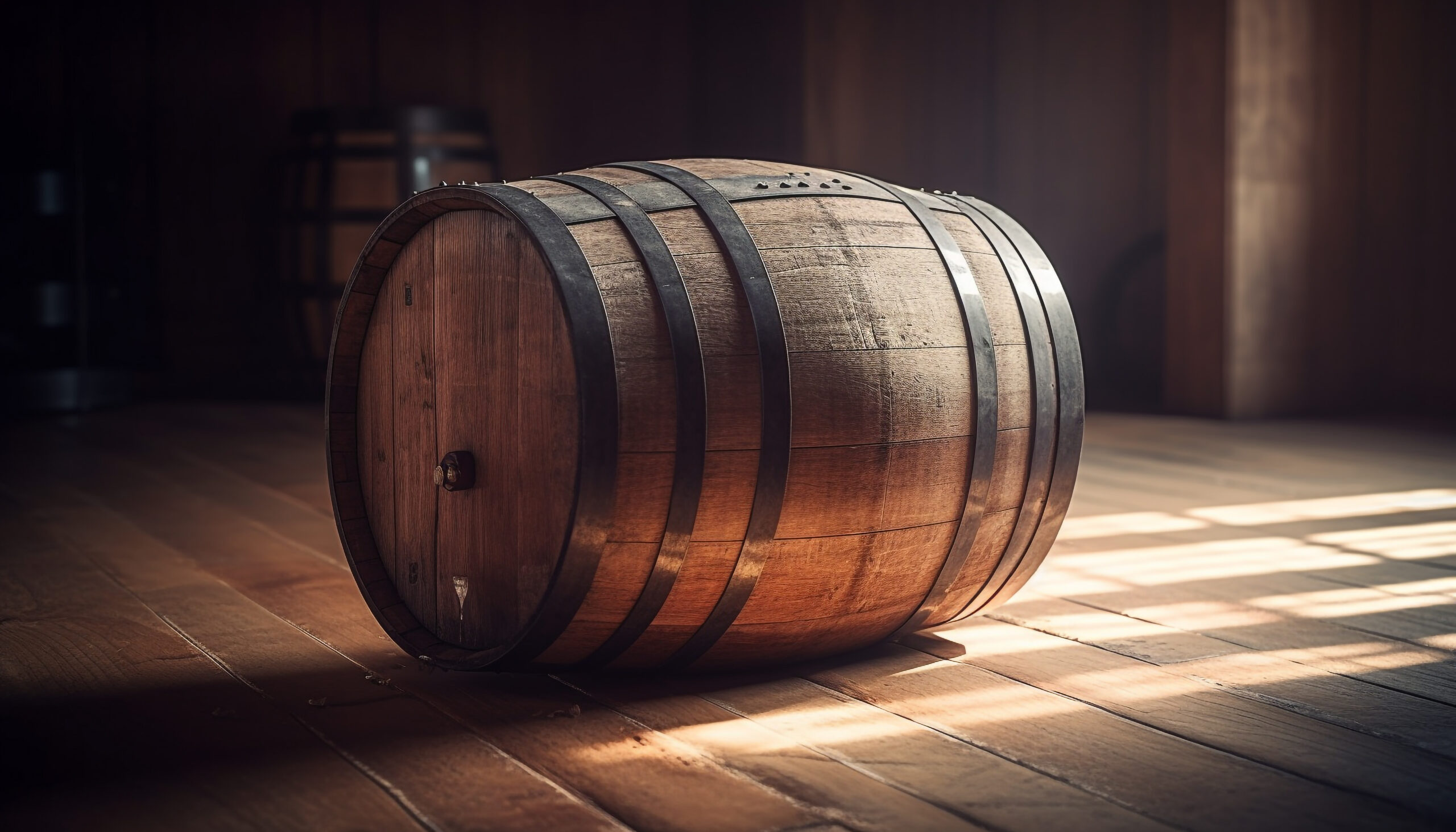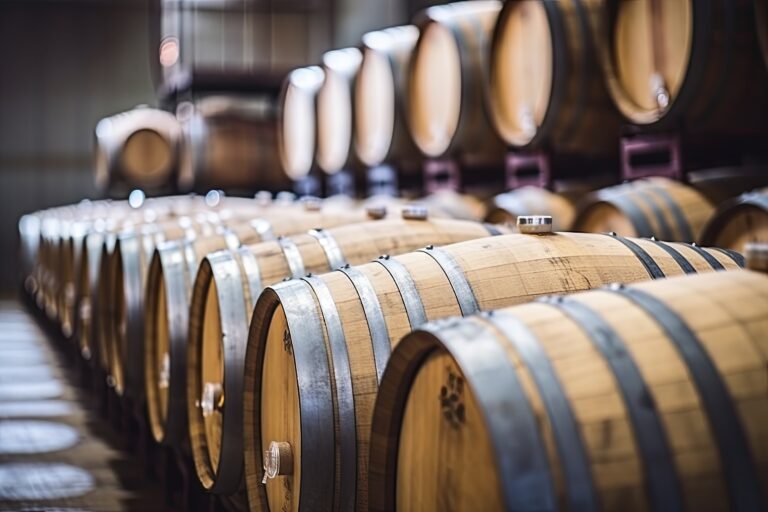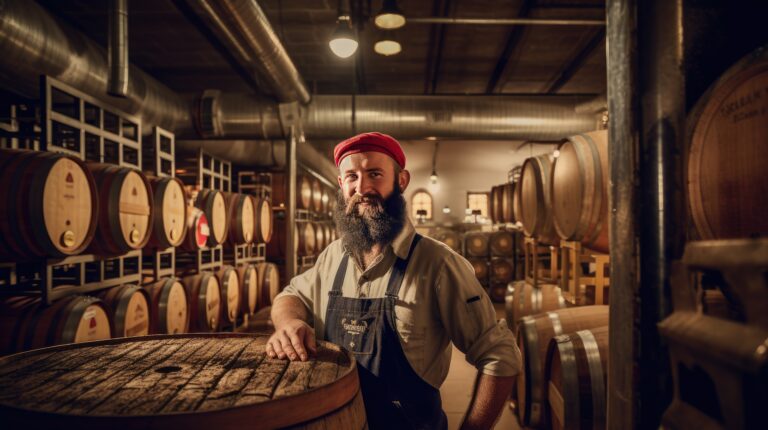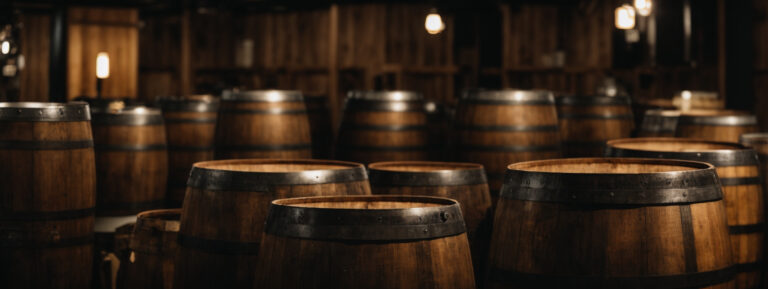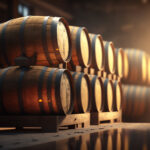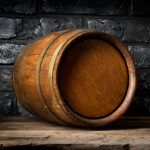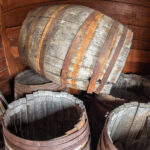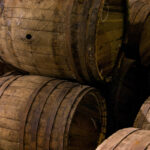Have you ever wondered why whiskey barrels are only used once? You’ve probably noticed that distilleries tout the fact that they use “virgin” oak barrels to age their spirits. There’s actually a really interesting reason behind this practice. As it turns out, whiskey barrels aren’t reused because the charred oak barrels impart lots of flavor to the spirit during the aging process. And once that barrel has been used, most of that flavor has been transferred to the first batch of whiskey. So using the same barrel again would result in a much less flavorful end product.
The Importance of Oak Barrels in Whiskey Making
The whiskey aging process relies entirely on oak barrels. Oak is ideal for aging whiskey because it’s porous enough to allow the liquid to breathe, yet strong enough to hold alcohol. As the whiskey sits, it absorbs flavor compounds from the wood like vanilla, caramel, and tannins.
- The type of oak and previous barrel use impact flavor. American white oak and charred barrels are common for bourbon. European oak and wine barrels are preferred for Scotch.
- Barrels are only used once. The first aging imparts the most flavor. Reusing a barrel results in a muted, woody taste.
- The barrel’s char or toast level determines flavor intensity. A heavier char means bolder, smokier notes. A lighter toast imparts more subtle hints of vanilla and spice.
- Environmental factors like temperature and humidity also influence taste. Colder conditions slow aging and produce lighter, sweeter notes. Warmer weather accelerates aging and creates darker, richer flavors.
A quality whiskey’s distinctive taste comes from the care, craft, and time invested by distillers and barrel makers alike. Their artful use of oak barrels to nurture raw distillate into an exceptional aged spirit is what gives great whiskey its characteristic flavor and aroma. Without the humble, unassuming oak barrel, there simply would be no memorable, mellow whiskey.
Why Fresh Barrels Are Used for Aging Whiskey
Fresh oak barrels are essential for aging whiskey because they impart flavor and aroma compounds to the spirit.
As whiskey ages, the alcohol soaks into the wood, absorbing organic compounds called congeners – things like vanillin, lactones, and tannins. These congeners give aged whiskey its characteristic taste and smell.
After a barrel’s first use, most of the readily available congeners have already been extracted. Reusing barrels means less flavor and aroma absorption for the whiskey.
Fresh barrels also allow for slight oxidation of the whiskey, which helps develop its complex flavors. Too much oxidation from an old, porous barrel can dull the flavor.
Barrel replacement is expensive, so most distillers reuse barrels a few times. But for the finest, most flavorful whiskeys, only new charred oak barrels will do.
The type of oak and level of char also matter. American white oak and a heavy char create more congeners than other woods and char levels.
So next time you take a sip of your favorite aged whiskey, think of the humble oak barrel and all the hard work that went into crafting such a perfect spirit. Fresh barrels may be used only once, but they create a taste that lasts forever.
How Whiskey Extracts Flavor From the Barrel
Whiskey gets much of its flavor from the barrels it’s aged in. As the spirit sits, it extracts compounds from the wood that give it a distinctive taste and aroma.
The Barrel’s Toast
The level of “toast”—how much the inside of the barrel is charred—impacts the flavor. More heavily toasted barrels impart smokier notes, while lighter toasts lead to sweeter flavors. The toast exposes the wood’s sugars and resins, allowing them to blend into the whiskey.
The Wood Itself
Oak has been the wood of choice for whiskey barrels. within oak, different species are used, like American white oak. The wood contributes vanilla and coconut notes, as well as tannins that give whiskey its characteristic bitterness and astringency.
Previous Contents
If barrels were previously used to age bourbon, sherry, port or wine, those also flavor the whiskey. Bourbon barrels lend sweet, vanilla notes. Sherry and port casks provide nutty, fruity flavors. Wine barrels impart floral, citrus tastes.
Whiskey barrels give the spirit an array of flavors and aromas through the type of wood, the toast, and any prior contents. As the whiskey interacts with the barrel over years of aging, these qualities blend and transform into the distinctive, complex taste of the finished product. The barrel’s singular role in creating whiskey’s flavor is why most distillers only use them once before replacing them.
What Happens During First Use of a Barrel
What Happens During First Use of a Barrel
When a barrel is first used, the wood interacts with the whiskey in complex ways, imparting oak flavors and aromas. The whiskey absorbs compounds like vanillin and lactones from the wood, which provide notes of vanilla, coconut and spice.
The whiskey also extracts ellagic acid, which provides a slightly bitter, woody taste. Tannins from the oak bind to organic molecules in the whiskey, smoothing out harsh flavors and improving mouthfeel.
As the barrel breathes, a small amount of oxygen enters. This oxygenation causes reactions that produce nutty, sherry-like flavors. The whiskey also pulls in aromatic compounds from the air surrounding the barrel, like bourbon and rum flavors from nearby aging spirits.
The first use of a barrel has the biggest impact on flavor. That’s why distillers want virgin oak barrels for aging premium spirits. After the initial aging period, about 50-80% of the flavor and color compounds have been extracted from the wood. While second or third use barrels still impart oak character, the effects are more subtle.
Many distilleries reuse barrels a few times before considering them “spent.” But for the boldest oak flavors, first-fill barrels can’t be beat. That’s why fine whiskeys are often aged in new charred oak casks. The first drink from these barrels is always the most memorable.
The Changes to the Barrel After One Use
After just one use, whiskey barrels undergo several physical and chemical changes that alter their ability to impart flavor and aroma to the spirit.
The Wood Opens Up
When first filled, whiskey barrels are tight, with little space between the wood staves. As the barrel expands and contracts during temperature changes, the wood opens up, creating small gaps. This allows more interaction between the whiskey and wood, enabling the transfer of compounds that influence taste and smell.
The Wood Gets Saturated
At first, the wood readily absorbs whiskey from the barrel. But over time, as more liquid is absorbed, the wood becomes saturated. This limits the amount of whiskey that can penetrate the wood, slowing the maturation process. After one use, most of the wood has become saturated, so less flavor and aroma is imparted to a second batch of whiskey.
Charring Breaks Down
The inner char layer breaks down with each use, exposing less char surface area to interact with the whiskey. Since charring is responsible for many flavor notes like vanilla, subsequent uses produce less of these flavors.
Bacteria Build Up
Bacteria, yeasts, and fungi grow on and inside the used barrel. These can produce off-flavors and musty aromas that get transferred to any whiskey put in the barrel. For this reason, most distillers avoid reusing barrels more than two or three times.
In the end, used barrels just aren’t able to produce the same quality of whiskey as new charred oak barrels. While more economical, whiskey aged in previously used barrels lacks the robust flavors, golden color, and distinctive aromas achieved during the first use. This is why most premium whiskeys are aged in new charred oak barrels.
Options for Re-Using Barrels After Aging Whiskey
Once whiskey has been aged in barrels, the barrels are no longer useful for aging more whiskey. However, there are a few options for re-purposing the barrels after their initial use.
Craft Breweries
Many craft breweries acquire used whiskey barrels to age their beers. The leftover whiskey flavors imparted to the wood add depth, richness, and complexity to stouts, porters and other full-bodied beers. Brewers fill the barrels with their beer and age them for several months to over a year before bottling.
Barrel-Aged Coffee
Some coffee roasters have started experimenting with aging green coffee beans in used whiskey barrels before roasting them. The beans absorb the whiskey aroma compounds in the wood, resulting in a liquor-infused flavor in the final roasted coffee.
Furniture
Used whiskey barrels have become popular for making rustic furniture like tables, chairs, benches, and bar stools. The authentic worn wood and metal bands are re-purposed to create a unique distressed look. Some companies specialize in crafting high-quality furniture from reclaimed whiskey barrels.
Barrel Planters
Whiskey barrels also make excellent planters for small trees, shrubs, and large flowering plants. Their size and shape are perfect for container gardening, and the aged wood adds visual interest. Some barrel planters are also mounted on casters so they can be easily moved around.
As you can see, there are many eco-friendly ways to give used whiskey barrels a second life. Re-using them helps reduce waste and creates artisanal products infused with the spirit of bourbon.
Popular Uses for Used Whiskey Barrels
Once whiskey has aged in charred oak barrels, those barrels are usually discarded. However, many find second lives and are popular for various uses.
Aging Other Liquids
Used whiskey barrels are ideal for aging and flavoring other alcoholic drinks like rum, brandy, or port. The leftover oak flavors and aromas imparted to the barrel from whiskey aging are absorbed by the new liquid, adding layers of flavor.
Home Décor
Charred oak whiskey barrels make attractive rustic decorations for homes and gardens. You’ll often see them used as tables, chairs, planters, or simply as decorative accents. Their worn, rounded shape and wood grain make a bold statement.
Barrel Crafts
Crafty individuals have found ways to repurpose used whiskey barrels into all sorts of items. Chairs, stools, clocks, cabinets, bowls, and lamps are just a few examples. The oak wood and metal hardware from barrels are high quality and built to last, perfect for creating custom pieces.
Barrel Staves
The individual oak planks that make up a whiskey barrel are called staves. Used staves are popular for woodworking projects and are sold by many barrel brokers and craft retailers. Staves can be used to make picture frames, candle holders, knife blocks, and more.
Whiskey barrels lead full and useful lives. Even after aging whiskey for years, they continue to find new purpose in homes, bars, and craft workshops around the world. Their distinctive shape and construction gives them enduring appeal and makes them ideal for reimagining in many forms.
The Impact of Re-Use on Whiskey Flavor
When whiskey is aged in barrels, the wood imparts flavor compounds into the spirit that create its distinctive taste. However, re-using barrels can negatively impact the whiskey’s flavor profile.
Loss of Wood Flavors
The first time a barrel is used, the whiskey absorbs desirable flavors from the charred wood like vanilla, caramel, and oak. With each subsequent use, there are fewer of these flavor compounds left to impart. The whiskey may end up tasting dull or one-dimensional.
Risk of Off-Flavors
Barrels that have been used multiple times increase the chance of the whiskey picking up unpleasant smells and tastes. Compounds from previous occupants can leach into the wood and get transferred to the new spirit. These off-notes are very difficult to remove and can ruin an entire batch.
Less Control
Master distillers carefully select barrels to achieve a specific flavor for each whiskey. Re-using barrels makes this process harder as the wood becomes less predictable. Subtle characteristics of the wood and char are lost over time and with each use, limiting the distiller’s ability to create an artisanal product.
For these reasons, most major whiskey producers prefer to use barrels only once. A fresh charred barrel helps create the distinctive taste that aficionados expect and ensures the highest quality product. While more expensive, single-use barrels are key to making premium whiskey.
FAQ: Answering Common Questions on Whiskey Barrels
You probably have a few questions about whiskey barrels and how they’re used. Here are some of the most frequently asked questions and their answers:
Why are barrels only used once?
Barrels are only used once for aging whiskey to maximize the interaction between the wood and the spirit. As whiskey ages in the barrel, the wood imparts flavors and aroma compounds to the whiskey. If barrels were reused, they would have less of an effect on the whiskey during aging. Using fresh barrels ensures the whiskey can absorb the maximum amount of flavor from the wood.
What happens to used barrels?
After barrels are emptied, distilleries usually sell them to bottlers, brewers, and wineries. The used barrels are ideal for aging and flavoring other spirits, wines, and beers. Some distilleries also repurpose used barrels as decor or furniture. Nothing goes to waste!
How long does whiskey age in barrels?
The aging time depends on the type of whiskey. Bourbon must be aged at least 2 years, but 4-6 years is more common. Scotch whisky is typically aged at least 3 years, and often much longer for premium brands, up to 30 years or more. The longer a whiskey ages, the more complex its flavor becomes. But after a certain point, it won’t improve significantly with more aging.
What are whiskey barrels made of?
The vast majority of whiskey barrels are made of American white oak. Oak is ideal because it’s porous enough to allow oxygen in and out, sturdy, and imparts pleasant flavors to the whiskey. Barrels are usually charred on the inside, which helps filter the whiskey and adds smoky flavors. Some distilleries also use other types of oak like European oak.
Final Thoughts
So there you have it, the inside scoop on why whiskey barrels are only used once. Basically, it comes down to maximizing flavor and quality. As the barrels age the whiskey, they impart desirable flavors and aromas from the wood into the spirit. But after one use, most of the flavor compounds have been depleted, so the barrels are retired. Using new barrels for each batch of whiskey allows distillers to craft a consistent product with the distinctive taste profile their customers expect. Though reusing barrels might seem more sustainable or cost-effective, it’s all about producing the best tasting whiskey. Next time you enjoy a glass of bourbon or Scotch, raise a toast to the humble whiskey barrel—the unsung hero that makes each sip special.
